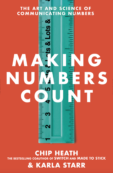Reader Greg Miller has made one of our book concepts stickier. Here’s the relevant passage of our book and then Miller’s improvement…
Another way to bring statistics to life is to contextualize them in terms that are more human, more everyday. As a scientific example, contrast the following two statements:
- Scientists recently computed an important physical constraint to an extraordinary accuracy. To put the accuracy in perspective, imagine throwing a rock from the sun to the earth and hitting the target within 1/3 of a mile of dead center.
- Scientists recently computed an important physical constraint to an extraordinary accuracy. To put the accuracy in perspective, imagine throwing a rock from New York to Los Angeles and hitting the target within 2/3 of an inch of dead center.
Which seems more accurate?
As you may have guessed, the accuracy levels in both questions are exactly the same, but when different groups evaluated the two statements, 58% of respondents ranked the statistic about the sun to the earth as “very impressive.” That jumped to 83% for the statistic about New York to Los Angeles. We have no human experience, no intuition, about the distance between the sun and the earth. The distance from New York to Los Angeles is much more tangible. (Though, frankly, the distance is still far from tangible. The problem is that if you make the distance more tangible—like a football field—then the accuracy becomes intangible. “Throwing a rock the distance of a football field to an accuracy of 3.4 microns” doesn’t help.)
Miller says: “I’ll offer this suggestion for improving the analogy of throwing the rock from New York to Los Angeles and hitting within 2/3 inch of dead-center. Units of distance are still too abstract. Better to say throwing a rock from New York to Los Angeles and hitting a 50-cent piece (which has a radius of about 2/3 inches.)”
Great point, Greg — thanks for making us more concrete!



